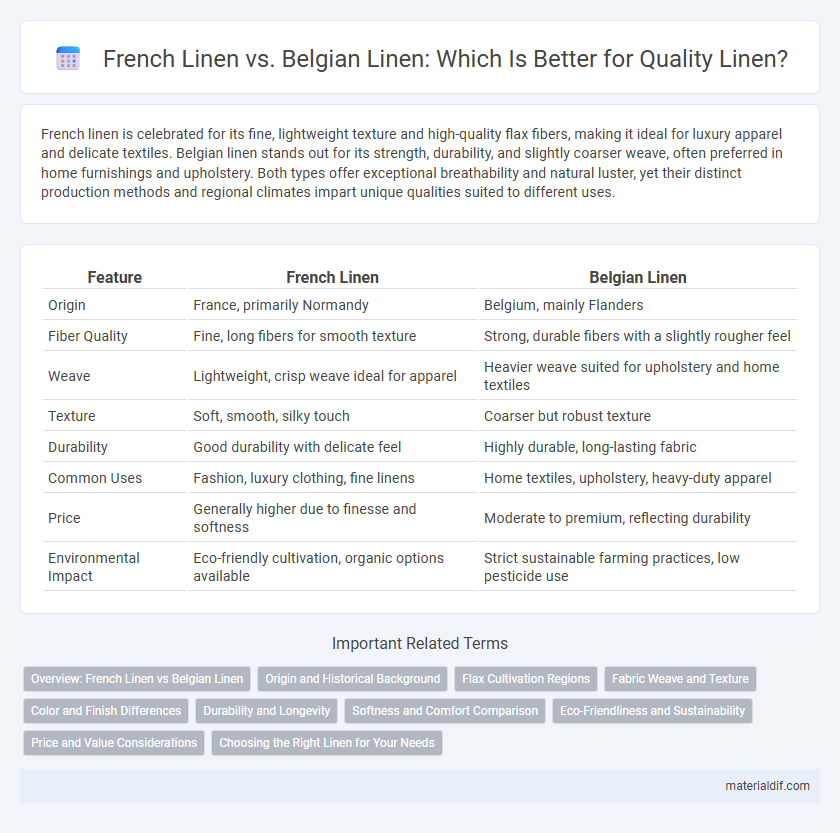French linen is celebrated for its fine, lightweight texture and high-quality flax fibers, making it ideal for luxury apparel and delicate textiles. Belgian linen stands out for its strength, durability, and slightly coarser weave, often preferred in home furnishings and upholstery. Both types offer exceptional breathability and natural luster, yet their distinct production methods and regional climates impart unique qualities suited to different uses.
Table of Comparison
| Feature | French Linen | Belgian Linen |
|---|---|---|
| Origin | France, primarily Normandy | Belgium, mainly Flanders |
| Fiber Quality | Fine, long fibers for smooth texture | Strong, durable fibers with a slightly rougher feel |
| Weave | Lightweight, crisp weave ideal for apparel | Heavier weave suited for upholstery and home textiles |
| Texture | Soft, smooth, silky touch | Coarser but robust texture |
| Durability | Good durability with delicate feel | Highly durable, long-lasting fabric |
| Common Uses | Fashion, luxury clothing, fine linens | Home textiles, upholstery, heavy-duty apparel |
| Price | Generally higher due to finesse and softness | Moderate to premium, reflecting durability |
| Environmental Impact | Eco-friendly cultivation, organic options available | Strict sustainable farming practices, low pesticide use |
Overview: French Linen vs Belgian Linen
French linen is renowned for its long flax fibers sourced primarily from Normandy, delivering exceptional softness and durability ideal for luxury textiles. Belgian linen, harvested from the Flanders region, is prized for its strength and natural luster due to the high-quality flax grown in the nutrient-rich Belgian soil. Both linens are celebrated for their eco-friendly cultivation and superior craftsmanship, making them preferred choices in premium home and fashion fabrics.
Origin and Historical Background
French linen originates from the Normandy and Brittany regions, renowned for their ideal climate and soil conditions that produce fine flax fibers. Belgian linen, primarily cultivated in Flanders, boasts a legacy dating back to the Middle Ages, recognized for its superior strength and durability. Both origins reflect deep-rooted traditions in linen craftsmanship, influencing the fabric's quality and texture.
Flax Cultivation Regions
French linen originates primarily from the Normandy region, renowned for its temperate maritime climate and rich soil, which produce long, fine flax fibers ideal for delicate, high-quality fabrics. Belgian linen is cultivated mainly in Flanders, where the combination of flat terrain, moderate rainfall, and well-drained clay-loam soil yields strong, durable flax fibers prized for robust and textured linen textiles. The distinct environmental conditions in these flax cultivation regions directly influence the fiber characteristics, resulting in unique qualities that differentiate French linen from Belgian linen.
Fabric Weave and Texture
French linen is renowned for its smooth, lightweight weave that offers a crisp yet soft texture, making it ideal for fine garments and luxurious bedding. Belgian linen features a denser, more textured weave, providing exceptional durability and a slightly rustic feel preferred for upholstery and home decor. Both fabrics exhibit natural luster and breathability, but French linen emphasizes refinement while Belgian linen highlights strength and character.
Color and Finish Differences
French linen is known for its naturally soft, muted tones often ranging from off-white to light beige, creating a rustic and organic appearance. Belgian linen typically features a smoother finish with a brighter, more uniform white shade, highlighting its refined and polished aesthetic. The difference in cultivation climates and flax processing methods in France and Belgium directly influences the color depth and tactile quality of each linen type.
Durability and Longevity
French linen is renowned for its fine texture and softness, but Belgian linen is often favored for superior durability and longevity due to its thicker fibers and traditional weaving techniques. Belgian flax fields benefit from optimal soil and climate conditions, producing robust fibers that enhance the fabric's strength and resistance to wear over time. Investing in Belgian linen ensures a longer-lasting textile ideal for items requiring heavy use, such as upholstery or workwear.
Softness and Comfort Comparison
French linen is renowned for its exceptional softness achieved through meticulous flax fiber selection and a longer retting process, resulting in a smoother and more supple fabric. Belgian linen, while slightly coarser, offers superior durability and a natural breathability that enhances overall comfort, especially in warmer climates. Both types provide high-quality comfort, but French linen is typically preferred for garments requiring a silky touch, whereas Belgian linen excels in home textiles demanding resilience.
Eco-Friendliness and Sustainability
French linen is renowned for its eco-friendly cultivation practices, utilizing minimal pesticides and emphasizing natural soil enrichment to promote sustainability. Belgian linen, while also sustainable, is noted for its stringent quality standards and water-efficient processing techniques that reduce environmental impact. Both linens offer durable, biodegradable fibers that excel in supporting sustainable fashion and home textiles.
Price and Value Considerations
French linen typically commands a higher price due to its traditional craftsmanship and reputation for exceptional softness and refined texture. Belgian linen, often more affordably priced, is prized for its durability and slightly coarser weave, offering excellent value for heavy-use applications. When considering price and value, French linen suits luxury bedding and apparel, while Belgian linen provides a cost-effective, long-lasting option for everyday textiles.
Choosing the Right Linen for Your Needs
French linen features a finer, softer texture ideal for lightweight apparel and delicate home textiles, while Belgian linen is renowned for its durability and heavier weave, making it perfect for upholstery and robust garments. Selecting the right linen depends on the desired fabric weight, weave density, and application, with French linen excelling in breathability and Belgian linen offering enhanced strength and longevity. Understanding these distinctions ensures optimal fabric performance, whether for elegant clothing or long-lasting interiors.
French Linen vs Belgian Linen Infographic

 materialdif.com
materialdif.com